“रुद्राय नीलकंठाय मृत्युंजयाय सर्वेश्वराय सदशिवाय श्रीमान महादेवाय नमः”
“Salutations to Rudra, the Blue-Throated One, the Conqueror of Death, the Lord of All, the Eternal and Auspicious Shiva”
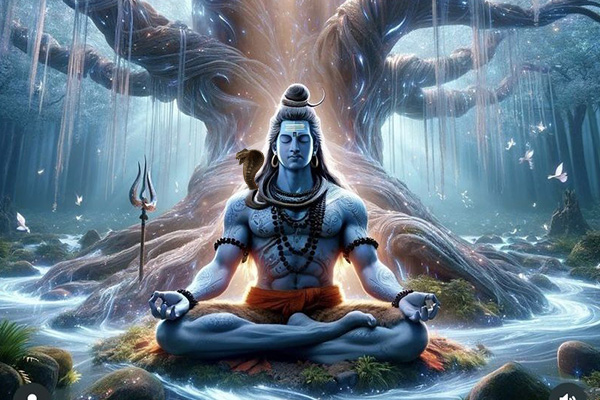
Shravan Maas (July-August) is revered as the most auspicious month among all. During Shravan Maas, the cosmos is charged with Shiva tattvas (Shiva elements), which purify the mind, senses, body, and soul through dedicated rituals to Lord Shiva.
This month, known as Avani in Tamil scriptures, marks the fifth month of the Solar year. As per Vedic astrology, Shravan Maas begins when the Sun enters the Zodiac Sign: Leo (Simha Rashi). During each Purnima of this auspicious month, the celestial realm is governed by Shravan Nakshtra, the birth star of Lord Vishnu, thus earning the name 'Shravan.' Each day during this time is auspicious for worshipping Shambhu (Shiva), and devotees perform prayers and Vedic rituals in Lord Shiva temples to seek His blessings.
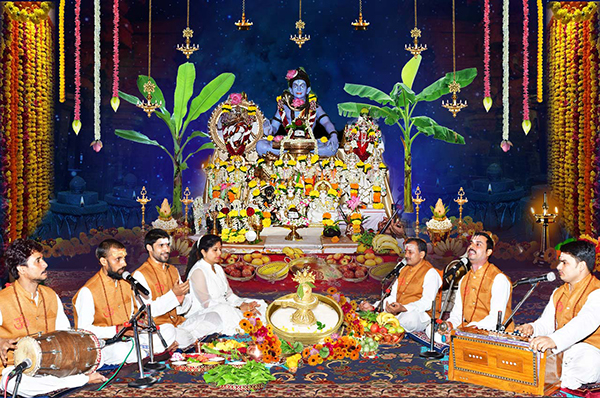
Click Here to Book Shravan Maas Mahapuja
In 2026, Shravan Maas begins on July 30, 2026 (Thursday) and concludes on August 28, 2026 (Friday) in North India as per the Purnimanta Calendar. Conversely, it differs by region- for Amanta states it runs August 13–September 11, 2026, and in the Nepali/Solar system it runs July 16–August 16, 2026. Please check Sawan (Shravan) Auspicious Dates and Muhurats to know more.
Shravan Month Importance | Significance of Sawan Maas
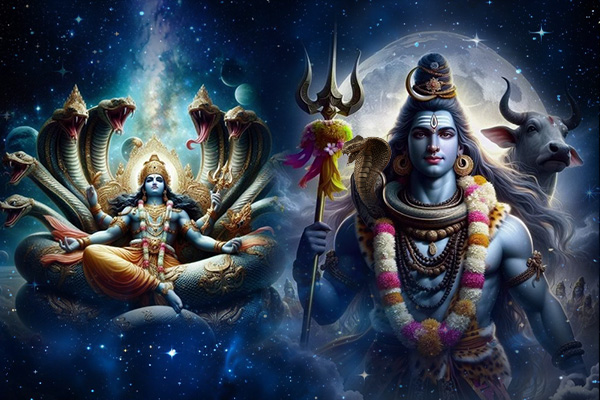
Shravan Maas is the first month of the Chaturmas period, which consists of four months (Shravan, Bhadrapada, Ashwin, and Kartik) dedicated to bhakti and revering the Divine. According to scriptures, during this period, Lord Vishnu enters Yoga Nidra (a state of deep meditation) on Adi Shesha (the seven-hooded serpent) beneath the Kshirasagara (cosmic ocean), while Lord Shiva takes care of the entire creation. We can interpret this as the preservation and nurturing aspect of life (governed by Lord Vishnu), making way for destruction (Lord Shiva). Ultimately, the old must give way to the new, so creation, nurturing, and destruction remain an endless cycle. Devotees follow a strict sattvic lifestyle and engage in devotion and worship to seek blessings and protection from the Divine Bhagwan Shiva during this period.
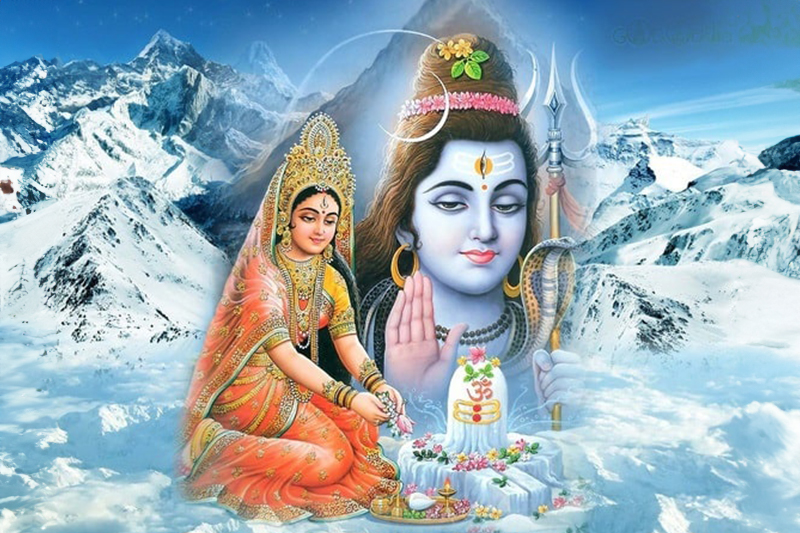
As per another Legend, Maa Parvati carried out hard penance and fasting throughout the month of Shravan to marry Lord Shiva and have Him as her consort. Pleased with her dedication and devotion, Lord Shiva obliged and fulfilled her wish. Many Women observe Shravan Somvar Fast or Solah Somvar Fast to attract a husband like Bhagwan Shiva in Shravan Month.

It was in the Shravan month when the search for Amrit started, also known as Samudra Manthan, which is the Churning of the Milky Ocean. During this time, 14 types of Jewels emerged from the ocean. Out of these fourteen, 13 were divided among the Asuras and the Devas. However, the 14th Jewel, Halahal, remained untouched due to it being the deadliest poison capable of destroying the entire universe. Lord Shiva then drank the Halahal and stored it in his throat, causing his throat to appear blue in color. From then on, he was also known as Neelkantha. All the Devas then started pouring water from the holy river Ganga to reduce the effect of the poison. They offered Bel Patra & Dhatura to Shiva as Medicine. Parvati Mata held the throat of Lord Shiva so that the poison doesn't spread. All Ganas and Shiva Devotees spend the entire time singing praises to Bhagwan Shiva to give him the strength to overcome this poison.
Another narrative is that Markandeya, the son of Markandu Rishi, received the grace of Shiva in the month of Shravan for longevity as He composed the Mahamrityunjaya mantra. Thus, this month devotees fast to receive good health throughout the year.
Also it is said that in this month, Lord Shiva visits His in-laws place and is welcomed with offerings. Thus it is the best time to receive His benevolent grace.
All of these events took place in the month of Shravan, making it highly auspicious.
Importance of Wearing Rudraksha in Shravan Month
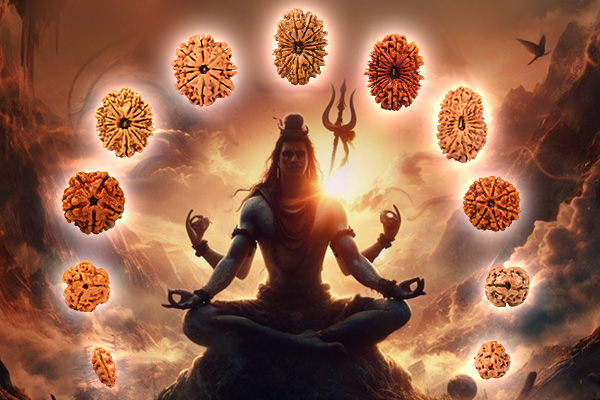
Rudra means Bhagwan Shiva & Aksha means Tears, Rudraksha are a gift from Bhagwan Shiva to Humankind to help them manifest their material & spiritual aspirations. Those dedicated to Lord Shiva consider wearing Rudraksha beads particularly auspicious during Shravan Maas. Mondays hold special significance throughout the year as they are dedicated to Lord Shiva. However, Mondays falling within Shravan Maas are considered exceptionally auspicious and are observed with heightened devotion, often involving fasting or specific religious practices. Rudraksha holds potent energies and wearing them during Shravan Maas amplifies the benefits multifold when compared to any other time of the year.
Shravan (Sawan) Auspicious Dates & Muhurats
There is a difference between the dates of Shravan across India because different regions follow different calendars. Northern Regions follow Purnimanta Calendar which is a lunar Calendar where the month ends on a Purnima (Full Moon) whereas Southern Regions follow the Amanta Calendar where the Month ends on an Amasya (New Moon). Thus, you can see almost a 15-day difference between the two. Some regions like Nepal, Uttarakhand & Himachal Pradesh follow a Solar Calendar thus their dates differ too.
If your state is not mentioned or you live abroad (Outside India) or are confused about which dates to follow we recommend you follow the Purnimanta Calendar
Rajasthan, Uttar Pradesh, Madhya Pradesh, Punjab, Himachal Pradesh, Uttarakhand, Chhattisgarh, Bihar & Jharkhand
July 30, 2026, Thursday
Shravana Begins *North
August 3, 2026, Monday
First Shravan Somwar Vrat
August 10, 2026, Monday
Second Shravan Somwar Vrat
August 17, 2026, Monday
Third Shravan Somwar Vrat
August 24, 2026, Monday
Fourth Shravan Somwar Vrat
August 28, 2026, Friday
Shravana Ends
Shravan Dates as per Amanta Calendar:
Andhra Pradesh, Telangana, Goa, Maharashtra, Gujarat, Karnataka & Tamil Nadu
August 13, 2026, Thursday
Shravana Begins
August 17, 2026, Monday
First Shravan Somwar Vrat
August 24, 2026, Monday
Second Shravan Somwar Vrat
August 31, 2026, Monday
Third Shravan Somwar Vrat
September 7, 2026, Monday
Fourth Shravan Somwar Vrat
September 11, 2026, Friday
Shravana Ends
Shravan Dates as per Solar Calendar:
Nepal, and some parts of Uttarakhand & Himachal Pradesh
July 16, 2026, Thursday
Shravan Begins *Nepali
July 20, 2026, Monday
First Shravan Somwar
July 27, 2026, Monday
Second Shravan Somwar
August 3, 2026, Monday
Third Shravan Somwar
August 10, 2026, Monday
Fourth Shravan Somwar
August 16, 2026, Sunday
Shravan Ends *Nepali
Significance of Each Day of the Week during Shravan Maas
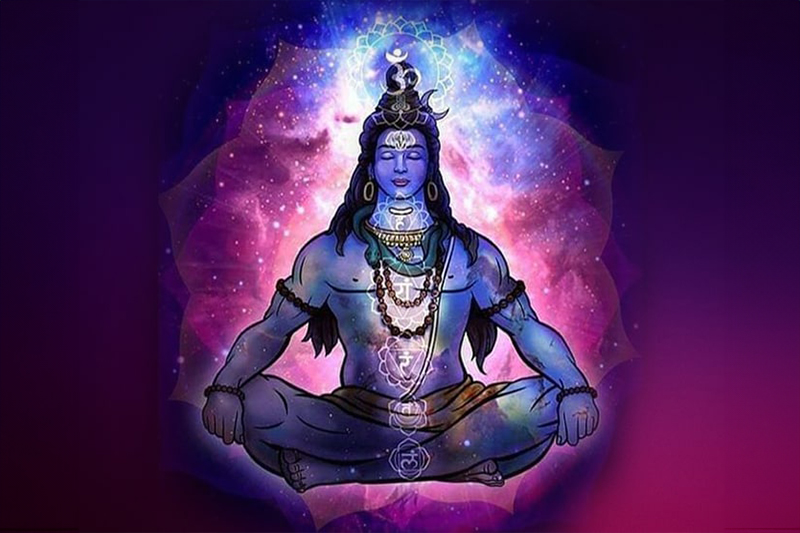
Each day of this month carries spiritual significance.
Monday:
It is the day to worship Lord Shiva.
Tuesday:
Women worship Gauri for the better health of their families.
Wednesday:
It is dedicated to Vithala, an incarnation of Lord Vishnu or Krishna.
Thursday:
It is for worshipping Buddh (Mercury) and Guru (Jupiter)
Friday:
It is for worshipping Lakshmi and Tulsi.
Saturday:
Dedicated to Saturn (Shani Dev). It is known as Shravan Saturdays or Sampat Sanivara (Wealth Saturdays), as one can pray to obtain wealth.
Sundays:
are for the Sun god. Sun worship was common practice in the Vedic period, and it is followed even now. Especially in Shravan, every Sunday, the Sun is worshipped.
What to do during Shravan Month (Sawan Maas)
1. Rudra Abhishek
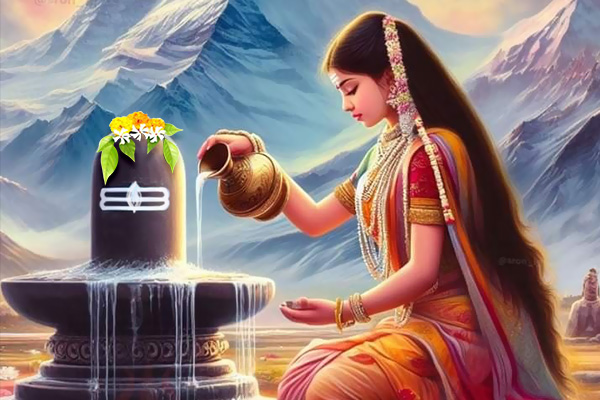
Rudra' means the one who is terribly infuriated, which is one of the divine qualities of Lord Shiva displayed during His cosmic dance, Tandava, for the annihilation of creations. Shiva, by virtue of this quality, is called Rudra. Abhishek is a ritualistic bathing of the Shivling which is a method of worship offered to the Divine for cleansing all the misgivings and sins of the worshipper.
Ancient Hindu writings mention Rudrabhishek, a ritual that removes the bad energies surrounding you, repents past misdeeds, and promotes the soul’s spiritual development. A Rudrabhishek puja is performed to please Lord Shiva, the destroyer. Rudra Abhishek purifies your mind and body, offers peace, fulfills your desires, and enlightens your soul.
How to Perform Shivling Abhishek at Home? Simple Rudrabhishek Puja Vidhi
Performing Shiva Abhishek includes the offerings of Gangajal or Water, Milk, Ghee, Panchamrit (a Mix of Milk, Honey, Sugar, Ghee, & Curd), Bael Patra (Bilva leaves), Vibhuti, Incense, Dhatura & Flowers so keep these items ready. Even if you are not able to arrange all items, you can simply perform Shivling Abhishek with Water also.
- Wake Up Early in the morning before Sunrise & have a bath
- Place the Shivling in Clean Vessel with the Jaldhari pointing towards North Direction and you will face East Direction
- Light a Diya Lamp
- Continuously Chant “Om Namah Shivaye” while making the offerings
- Offer Water
- Offer Milk
- Offer Ghee
- Offer Panchamrit
- Offer Bilva Leaves
- Apply Vibhuti & Sandalwood Paste on the Shivling
- Offer Dhatura
- Offer Flowers
- Offer Sweets
- Light Dhoop Incense and offer the Dhoop to the Shivling & spread it around
- Fold your Hands in Namaskar & Perform Half Pradakshina around the Shivling
- Walk Clockwise start from left side of the Jaldhari, do not cross the Jaldhari when you reach the other side and Walk back to the same point anticlockwise forming a Crescent Moon around the Shivling.
- Chant “Om Shanti Shanti Shanti”
- Ask for forgiveness for any mistakes made during the ritual and conclude your puja.
This method can be done at home during Shravan, especially on Shravan Somvar (Mondays). There is a detailed Rudrabhishek Puja Vidhi as per Shastra with Vedic Mantra. It may be difficult for individuals who are not well versed with Sanskrit & Mantra Chanting.
Read More: Rudrabhishek Procedure Vedic Vidhi
Rudra Centre has team of 250+ Karmakandi Pandits from Kashi who have been curated by Sakhashree. You can book Rudrabhishek from our team of pandits and watch all rituals live on WhatsApp, Youtube, Skype or Zoom
2. Fasting (Vrat)
.jpg)
During Shravan Maas devotees mostly undertake four types of Vrats (fasts) which are Sawan Somwar Vrat, Solah Somwar Vrat, Pradosh Vrat and Mangala Gauri Vrat.
- Sawan Somwar Vrat – Sawan Somwar Vrat is observed every Monday (Somvar) in the month. There are mostly 4 to 5 Mondays during Shravan. (Detailed Shravan Somvar Rat Vidhi is mentioned in the next section)
- Solah Somwar Vrat – It is observed by young girls to find the most ideal husband. They fast for 16 consecutive Mondays starting from the first Monday of this month.
- Pradosh Vrat – Pradosh Vrat is observed on the 13th day (Trayodashi tithi) of both Krishna Paksha and Shukla Paksha. The thirteenth day is considered extra special for invoking and worshipping Lord Shiva. On this day, devotees keep a strict fast and perform Shiva puja during the Pradosh Kaal.
- Mangala Gauri Vrat – Mangala Gauri Vrat is observed on Tuesdays in the Shravan Maas. The fast is observed for happy married life and well-being and the long life of the partner.
- Shani Vrat – Shani Vrat is observed on Saturdays during the Shravan Maas primarily for pacifying Lord Shani and gaining His blessings.
Types of Fast
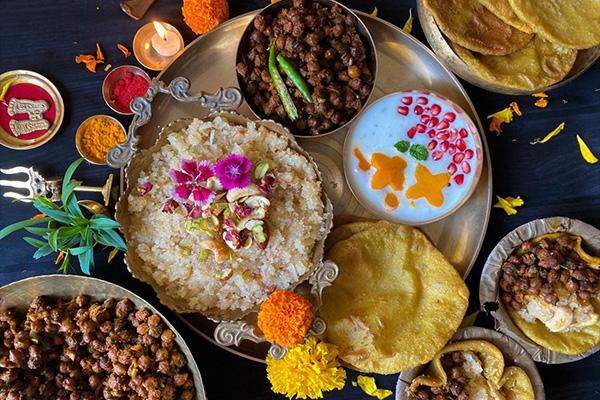
-
Falahaari Upvas (Eating Only permitted Fasting Foods)
The Falahari Upvas primarily includes fruits along with other options like Sabudana, Samak rice, Buckwheat Flour, Water Chestnut Flour, Roasted Peanuts, Makhana, Paneer & Milk. You can only eat between Sunrise to Sunset. It's recommended to avoid eating after Sunset. This is one of the most popular Fasting Types amongst Indians. -
Prat Upvas (2 Meals a Day)
During this fast, breakfast is skipped and only two meals are consumed for the entire day. You can only eat between Sunrise to Sunset. After Sunset eating should be avoided. -
Adhopvas (1 Meal a Day)
Also known as the evening fast, only one meal is taken during the day. You can only eat between Sunrise to Sunset. After Sunset eating should be avoided. -
Ekaharopvas (Single Food Fast)
This fasting involves eating only one type of food in each meal, for example eating only fruit for breakfast, only vegetables for lunch & grains like wheat or rice for dinner. The preparation style should be sattvic and too much oil and spices should be avoided. -
Rasopvas (Juice Fast)
During this fast, eating solid foods like grains and certain fruits is avoided, and only juices of fruits and vegetables are consumed. -
Phalopvas (Fruit and Vegetable Fast)
This fast focuses on consuming only juicy fruits and vegetables, with cooked vegetables as an alternative if needed. -
Dughdopvas (Milk Fast)
Known as the milk fast or Dugdha Kalp, this involves consuming only milk multiple times a day during fasting. -
Takropvas (Avoiding Ghee and Sour Foods)
This fast requires avoiding ghee and sour foods for a specified period, typically followed for up to two months. -
Purnopvas (Water Fast or Full Day)
Purnopvas involves abstaining from food and relying solely on fresh water while adhering to other traditional rules. -
Laghu Upvas (Short-Term Fast)
When a Purnopvas or Full Fast is observed for 3 to 7 days, it's called a Laghu Upvas. -
Toote Upvas (Alternating Fast)
This involves cycles of Purnopvas or full fasting for several days, followed by light natural foods for a period, repeating until desired results are achieved. -
Deergh Upvas (Extended Fast)
This extended Purnopvas or Full Fast lasts for a set number of days, typically ranging from 21 to 60, and ends when the body signals a need for food or after detoxification goals are met. -
Nirjala Upvas (Waterless Fast)
Nirjala Upvas is an intense form of fasting where one abstains from both food and water. Due to its rigorous nature, it is recommended only for those in good health and should be approached with caution.
Disclaimer: Please consult a health professional before opting to fast, especially if you plan to undertake a very austere fast like Nirjala or any form of Purnopvas
Devotees can observe various types of fasts based on their circumstances. However, for Shravan Somvar, people usually opt for Falahaari Upvas/Vrat.
Shravan Somvar Vrat Vidhi, Muhurat & Katha (Sawan Monday Fasting Procedure, Timings & Story)
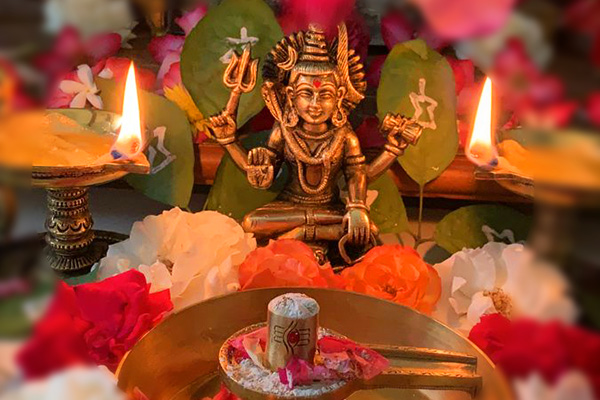
Fasting during Shravan Maas has been mentioned in the Shiva Purana. According to Shiva Purana, those who observe fast during Shravan Maas have their desires fulfilled and are blessed with the grace of Shiva. Shravan Maas Somvar is very important for the devotees of Lord Shiva.
What can you eat in Shravan Falahari Vrat?
Falahaari Vrat Upvas Permitted Food List
All Fruits, Berries & Nuts
Milk & Milk Products (Buttermilk, Yogurt, Paneer, Unsalted Butter, Ghee)
Sweet Potato
Potato
Sabudana (Sago)
Kuttu Aata (Buckwheat Flour)
Peanuts
Dry Fruits
Singhara Aata (Water Chestnut Flour)
Makhana (Fox Nut)
Suran & Ratalu (Yams)
Samak Rice (Barnyard Millet)
Rajgira (Amaranth)
Lauki (Bottle Gourd)
Cucumber
Pumpkin
Lemon
Raw banana
Ginger
Tomato
Carrot
Aaluki (Colocasia)
Cumin seeds
Black Pepper
Red Chilli
Dried Raw Mango Powder
Mishri (Rock Sugar)
Sendha Namak (Pink Salt)
What should be avoided in Shravan Falahari Upvas Vrat?

We recommend sticking to the items mentioned in the list above. There are some items which should be strictly avoided as these are not sattvic. This includes all Non-Vegetarian Foods like meat, fish, eggs.
Onions, Garlic brinjal, mushrooms, leek, shallot, leafy vegetables, Cabbage, cauliflower, capsicum, legumes (Moong, Rajma), lentils (Daals) and most grains & flours like wheat, rice, corn should be avoided.
Certain spices like mustard seeds, asafoetida, fenugreek seeds, turmeric, salt & garam masala should be avoided. Instead of Salt you can use Sendha Namak or Pink Salt.
Apart from this tobacco, alcohol or any such intoxicants should be avoided.
Some observe Falhara Fast for the entire Shravan Month, some break it after Sunset, some observe this fast only on Mondays. It depends on the individual on how they want to please the divine with their austerity.
Another type of fasting is that you can keep a Maun Vrat (Silence) for one whole day in this month and chant mantras in your mind.
Benefits Of Fasting During Shravan Maas
- Divine Grace & Blessings of Bhagwan Shiva
- Self-Control: Fasting helps you practice discipline and control over your cravings.
- Detox: It gives your body a break, helping it get rid of toxins and feel more energetic.
- Better Digestion: Fasting lets your digestive system rest, making digestion smoother and nutrient absorption better.
- Weight Control: Skipping meals can help manage weight by cutting down on calories.
- Boosted Metabolism: It may speed up your metabolism, keeping your body functioning well.
- Blood Sugar: Fasting under control can help stabilize blood sugar levels.
- Peaceful Mind: It can bring mental clarity and a sense of calm, helping you feel more centered.
- Repairing of Damaged Cells: Some research indicates that fasting can help us reach a state of autophagy which helps in getting rid of damaged cells in the body & also repair cells and body organs.
The Shravan Fasting Story | Sawan Somvar Vrat Katha
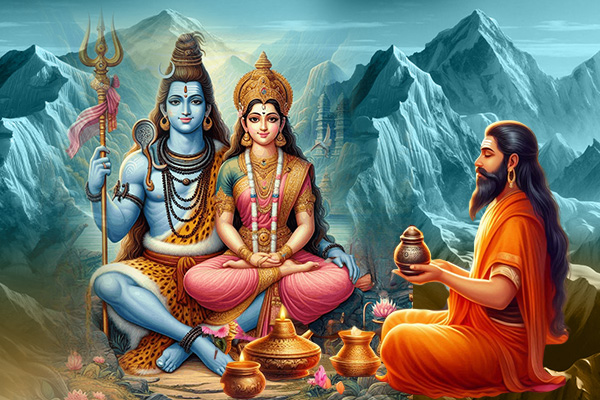
The Shravan Somvar Katha is the story of a rich merchant who had everything except a son. He was a dedicated devotee of Lord Shiva and used to sincerely worship the Shivling and Goddess Parvati on every Monday, fervently praying for a son. Seeing his dedication Maa Parvati, Lord Shiva's consort, requested Lord Shiva to grant the merchant his wish. Lord Shiva agreed and blessed the merchant, however the Lord told Goddess Parvati that the merchant will have a son but the child will live for only 12 years. The merchant overheard this conversation between Lord Shiva and Maa Parvati, but he did not reveal this fact to his wife or anyone else. In due course of time a son was born to him and he and his wife were overjoyed. Though the merchant celebrated his son’s birth lavishly and donated amply, he was still sad, as he knew that his son would not live beyond 12 years. He started worshipping Lord Shiva and Parvatijee more intently and never missed observing fast on Mondays, praying that his son be granted longevity, beyond 12 years.
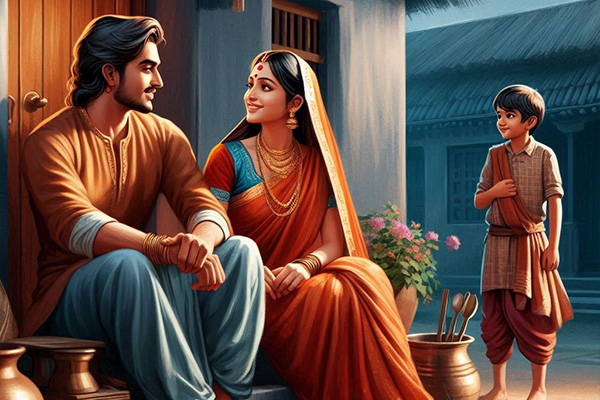
Years passed by and the merchant’s son grew up to be a handsome young boy and when he turned 11, the merchant’s wife wanted her son to get married. But the merchant knew about his son’s life span and refused to agree to his wife’s wish. He decided to send his beloved son to the holy city of Kashi for education in spiritual knowledge. He requested his wife’s brother,i.e., his brother-in-law, to accompany his son to Kashi and arrange for the best spiritual education. The merchant instructed his brother-in-law to organize spiritual discourse gatherings at every place they passed through and offer enough donations to the needy.
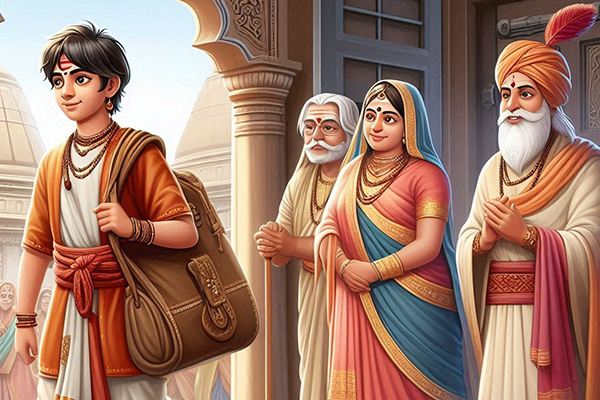
The merchant’s son, left for Kashi with his maternal uncle. On the way they followed the instructions of the merchant, in every place they halted, by arranging spiritual gatherings, donating to the needy and satisfying Brahmins by feeding them and offering daan dakshina. During their journey, they once reached the capital city of a King whose daughter was to get married that day. Though there was festivity all around, the bridegroom’s father was worried and anxious as his son was blind in one eye, and he knew that his son would not be accepted by the King. The bridegroom’s father sent his men to find out a handsome boy to be the proxy bridegroom for the wedding. When the men came across the merchant’s son, they found him perfect for the requirement. They convinced the maternal uncle of the boy, and told him that the boy would be released once the wedding ceremony is finished. Understanding the situation, the maternal uncle convinced the merchant’s boy to stand in as a proxy bridegroom and the boy agreed.
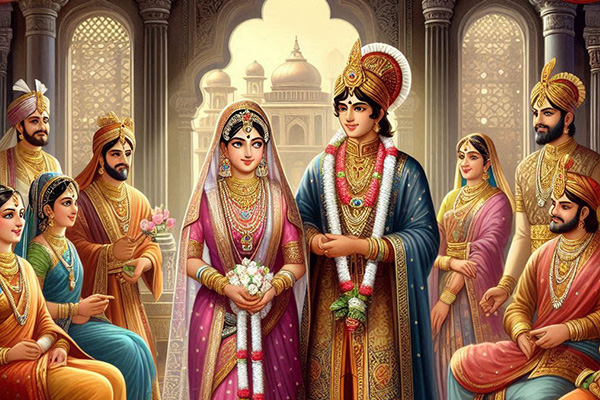
The people of the kingdom were happy, praised the handsome young bridegroom and thanked their luck for getting such a suitable match for their Princess. The wedding rituals were performed and the merchant’s son and Princess were married. However, before leaving, the merchant’s son wrote on the chunri(long scarf) of the bride, that he was not her actual bridegroom, though they were now married. He disclosed that the actual bridegroom was blind in one eye and a Prince, while he was a rich merchant’s son. The Princess had noticed the merchant’s boy writing something on her chunri and when she read it, just before leaving for her in-law’s place, she was shocked and upset and refused to accept the one eyed boy as her husband. The Princess stayed back in her father’s palace and the bridegroom and party returned back to their kingdom without the bride.
The merchant’s son and his maternal uncle reached Kashi and started his spiritual education at the best place. He was focused and dedicated to learning and his maternal uncle diligently organized spiritual gatherings and continued donating, regularly, praying for the good health and well being of his sister’s son.
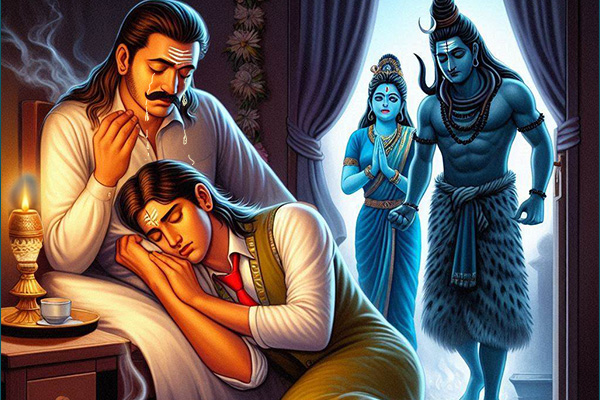
Time passed and on the last day of the 12th year of the merchant’s son, Lord Shiva’s words manifested. The young boy experienced a pain in his chest and succumbed to death. The maternal uncle of the boy was conducting his daily rituals and found the boy dead in the room. However, the grieved maternal uncle kept his composure, did not reveal anything and carried on with the daily ritual of feeding the Brahmins etc. Once the rituals were over he broke down, howled and cried by beating his chest. Coincidently, Lord Shiva and Parvatijee were passing by that place and heard the wail and mourn and noticed the dead body of the merchant’s son. Understanding what had happened, the compassionate Divine Mother Parvati was moved and requested Lord Shiva to resurrect the life of the merchant’s son as the Lord looked after all beings and the merchant was His sincere devotee who worshiped Him and never missed a Monday fast. On Her behest, Mahadev breathed life back in the merchant’s son by sprinkling Gangajal. The boy woke up, back to life. His maternal uncle was overwhelmed with joy.
When the merchant’s son finished his education, he and his maternal uncle started their journey back home and continued making donations and holding spiritual discourse gatherings. They reached the kingdom where the merchant’s boy had got married to the Princess of that kingdom. The King recognized the merchant’s boy and respectfully brought him to the palace, honouring him as his son-in-law. Later, the King organised his daughter to leave for her in-laws’ place on an auspicious day and gifted the merchant’s son with rich dowry.
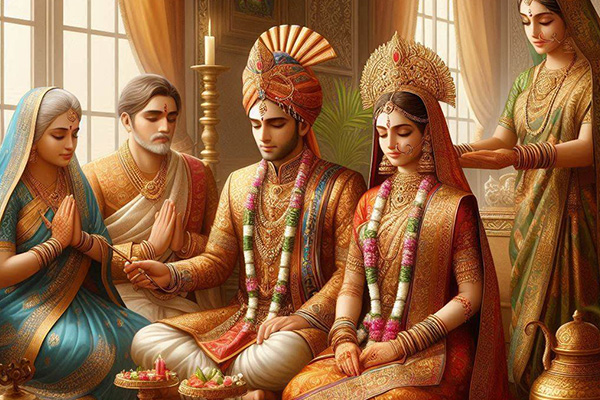
The merchant’s son, along with his wife and maternal uncle reached back to his hometown. The merchant could not believe what he saw and knew it was a miracle and grace of Lord Shiva. The boy and his wife touched the feet of the parents and were lovingly welcomed back. This vrat katha(Shravan fasting story) clearly shows how meritorious it is to observe the Sawan Somvar Vrat.
3. Worship Of Lord Shiva (Shravan Somwar Puja Method)
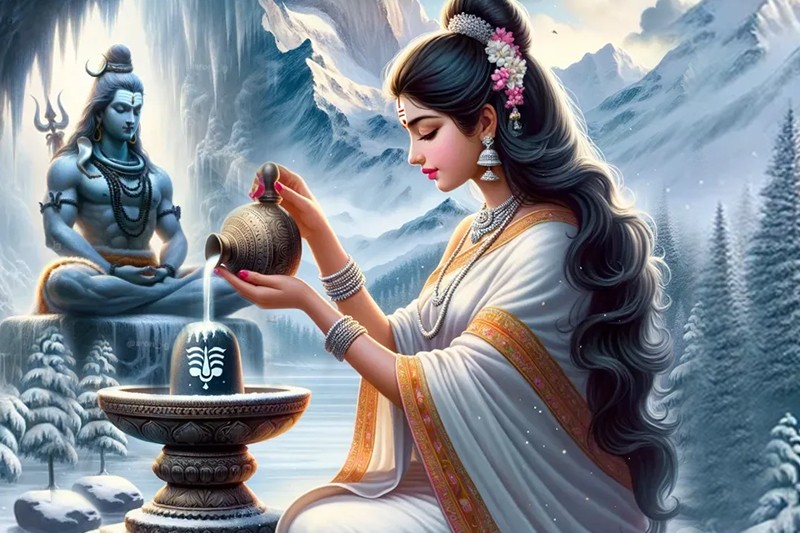
Devotees should wake up early, preferably during Brahma Muhurat, clean the Puja altar, take a bath, and wear clean clothes. Purify the house with water mixed with Ganges water. Take Sankalpa to observe the fast.
Perform the Abhishek ritual on the Shivalinga. You can use the technique mentioned in the above sections. It is believed that Lord Shiva is pleased even with simple offerings of wild creepers and flowers that are easily available, such as Aak flowers, Bel leaves, and Datura. Offer bhasma, sandal paste, lotus flowers, and Rudraksha beads during prayers.
One may chant the following Shiva Mantras using a Rudraksha rosary or silently in mind. Chanting may be done at a specified time and with a specific number of counts (108 times or multiples of it) in the morning or evening, or you may do ajapa-japa and silently repeat the mantra throughout the day. You may chant any of the mantras mentioned below
ॐ नमः शिवाय
Om Namah Shivaya II
Om, I am One with the Supreme reality.
Mahamrityunjaya Mantra:
ॐ त्र्यम्बकं यजामहे सुगन्धिं पुष्टिवर्धनम् |
उर्वारुकमिव बन्धनान्मृत्योर्मुक्षीय माऽमृतात् ||
tryambaka yajamahe sugandhi pushtivardhanam
urvarukamiva bandhan mrityormukshya mmrat
OM! We worship the three-eyed Lord, who is fragrant and Who nourishes and nurtures all beings. As the ripened cucumber (without the intervention of the gardener) is freed from its bondage (to the creeper), may He liberate us from death for the sake of immortality.
Rudra Gayatri Mantra:
ॐ तत्पुरुषाय विद्महे महादेवाय धीमहि
तन्नो रुद्रः प्रचोदयात्॥
Om Tatpurushaya Vidmahe Mahadevaya Dhimahi
Tanno Rudrah Prachodayat
OM! Let me meditate on the great Purusha, Oh, greatest God, give me higher intellect, and let God Rudra illuminate my mind.
You can also read stories of Lord Shiva, study the Shiva Purana, and meditate on His holy form. this is true Bhakti.
Worship should be offered twice a day: first in the early morning, and again after sunset. During the day, devotees may consume fruits and permitted foods while fasting. After sunset, a regular sattvic meal can be taken. Remain in a devotional mood throughout the day and avoid consuming alcohol, tobacco, or non-vegetarian food.
How to do Japa?
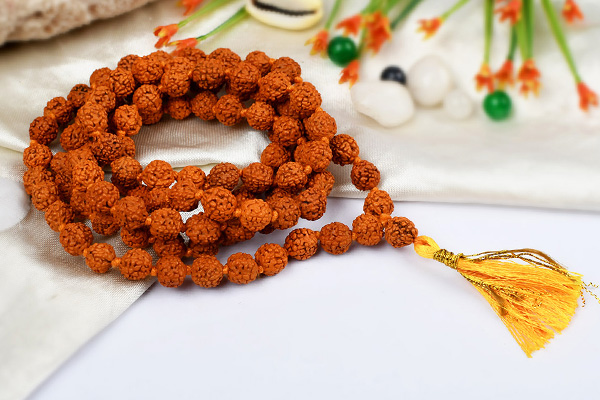
Japa, derived from the Sanskrit root 'jap' meaning “to utter in a low voice, repeat internally, mutter.” It can also be interpreted as 'ja' meaning to destroy the cycle of birth, death, and reincarnation, and 'pa' meaning to destroy one's sins. In yoga, Japa is the practice of repeatedly chanting a beej mantra or specific affirmation to concentrate the mind which leads to meditation through uninterrupted focus over time. This practice is often done using a Japa mala, where the practitioner counts each of the 108 beads as they chant the mantra.
To practice Japa meditation, hold the mala in your right hand, looping it over the middle (or middle and ring) finger with the guru bead pointing up and the other beads hanging down. Use your thumb to grasp and slide the first bead to one side of the guru bead, chanting the mantra as you do so. Ensure that your index finger does not touch the mala, as it is believed that it contains negative energies. Pronounce your mantra clearly and keep your eyes closed during the practice by completing a round of 108 beads.
A Japa mala typically has 108 beads which holds a spiritual significance in Hinduism and Buddhism. It is believed there are 108 earthly desires, and some traditions state that humans possess 108 feelings related to the past, present, and future. The number 108 also arises from the multiplication of 12 constellations with 9 arc segments. Symbolically, 1 represents God, 0 stands for completeness, and 8 signifies infinity. The 109th bead, the guru bead, is the starting point for counting the mantra Japa and honors the student-guru relationship.
Performing Shiva Mantra Japa using a Rudraksha Mala is considered extremely meritorious during Shravan.
Click Here to Buy Rudraksha Japa Mala
Recitation of Stories & Legends of Bhagwan Shiva
Share captivating stories of Bhagwan Shiva with children which focuses on his divine adventures and profound teachings. Typically, elders in the family, especially grandparents, pass down these stories to younger generations which instils the values like courage, compassion, humility, and devotion. Through storytelling sessions, children can deeply connect with these moral and spiritual lessons that can shape their character and guide them towards becoming better individuals.
Organize Paths and Bhajans
Jagrans and Bhajans are gatherings where people come together to sing hymns and songs for Lord Shiva. These sessions create a heartfelt atmosphere where everyone can show their love and appreciation for Lord Shiva. During the month of Shravan, participating in Jagrans and Bhajans fills the air with a strong sense of spirituality, making everyone feel uplifted. The chanting and music make a peaceful and relaxing environment which helps people feel closer to the divine. These gatherings allow devotees to deepen their connection with Lord Shiva's energy thus making Shravan a special and spiritual time for everyone involved.
Pilgrimage & Teerth Yatra
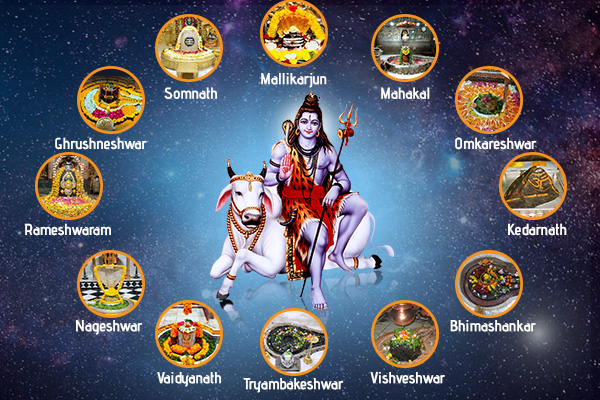
The 12 Jyotirlingas are the twelve most important temples of Lord Shiva, representing the places where Lord Shiva manifested in His Lingam form. These temples are Somnath, Mallikarjuna, Mahakaleshwar, Omkareshwar, Vaidyanath, Bhimashankar, Rameswaram, Nageshwar, Kashi Vishwanath, Trimbakeshwar, Kedarnath, and Grishneshwar. Throughout the entire Shravan Maas, especially on Mondays, they are thronged by lakhs of Shiva devotees. Fairs, yatras, elaborate pujas, and yagnas are organized here as devotees pray to Shiva with much gusto, fanfare, and devotion. Visiting the Jyotirlingas during Shravan Maas is considered highly auspicious.
Kanwar Yatra
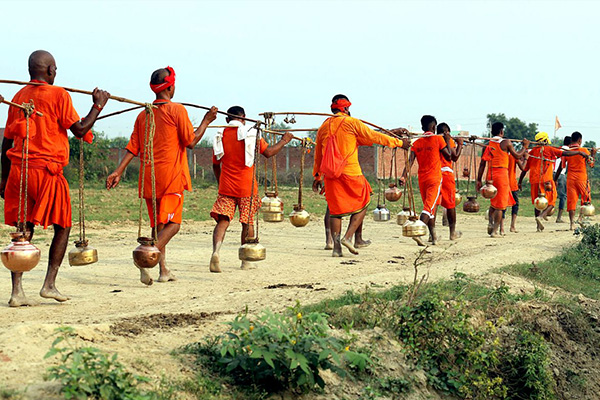
The Kanwar Yatra is an annual pilgrimage undertaken by Lord Shiva devotees, popularly known as Kanvari, during Shravan Maas in North of India. In this Yatra, devotees collect Gangajal (water from the holy river Ganges) from Hindu pilgrimage places such as Haridwar, Gaumukh and Gangotri and Sultanganj in pots and carry them on foot to major Shiva temples such as Kashi Vishwanath, Baidyanath, and Deoghar by walking hundreds of miles along with chants of 'Jai Bhole' and 'Jai Shiv Shambhu'. On reaching, they offer the water to Shivling in the temple as Jal abhishekam. The Yatra has gained immense popularity in the last couple of decades and has now become one of India's largest annual religious gatherings, with an estimated strength of more than 12 million participants.
Shravani Mela
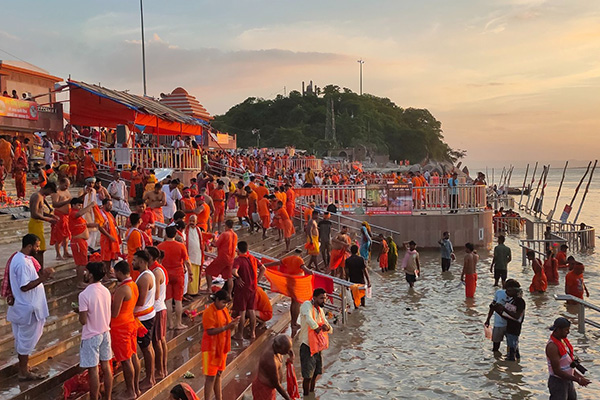
During the Shravan Maas, the Shravani Mela has become a major festival in Deoghar, Jharkhand. In the annual month-long mela at the Baba Baidyanath temple, Deoghar thousands of Shiva devotees collect Gangajal from Sultanganj and offer it at the Baba Baidyanath Dham, which is around 100 kilometres away.
Other Festivals Celebrated During Sharavan Month
Since Shravan last for a month, there are a lot of other auspicious festivals which are celebrated within Sawan Maas itself. They have been mentioned below
Kamika Ekadashi Vrat (Sunday, August 9, 2026)
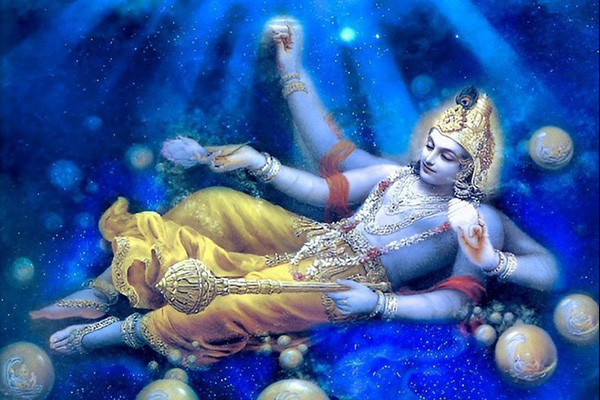
Kamika Ekadashi Vrat is observed on the 11th day of the Krishna Paksha (waning phase of the moon) in the Hindu month of Shravan. Devotees fast and worship Lord Vishnu to seek his blessings and forgiveness for past sins. It is believed that observing this fast with devotion can cleanse one's soul and bring prosperity. The day is marked by prayers, recitation of Vishnu Sahasranama, and offering of fruits and flowers to Lord Vishnu.
Nag Panchami ( Monday, 17 August 2026)

It is a traditional Vedic worship of snakes or serpents observed by the followers of Vedic customs. The worship, prayers and rituals are performed on the fifth day of the bright half of the lunar month of Shravan (July/August).
The divine abode of Nagas is believed to be Naga Loka. The snake gods are worshipped for the welfare of the family. Serpent deities of silver, stone or wood or the painting of snakes on the wall are given a bath with milk and then respected.
Read More: Nag Panchami
Shravan Putrada Ekadashi (Sunday, August 23, 2026)
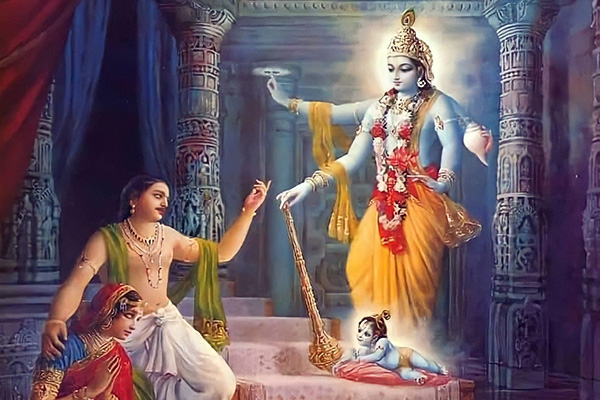
Putrada Ekadashi is observed for the worship of Lord Vishnu. A married couple who cannot have a male child after marriage for quite a long time observes this Ekadashi by pasting and offering prayers to Lord Vishnu. ‘Putrada’ is derived from the Sanskrit root ‘Putr’ meaning ‘son’ and ‘ada’ meaning ‘bestowing or giving’. The Vedas consider Lord Vishnu who in a sense is Brahma and Rudra Himself, to be the bestower of the benedictions. One may question the significance of this Ekadashi and consider it partial toward the female child. It is to be understood that it is celebrated by the married couple who have no son after marriage for a quite long time. In ancient times, when all the daughters were given in marriage to the family's worthy of worship, the aging parents who had only daughters needed a son for support as a son with his wife would then take care of their parents.
Read More: Putrada Ekadashi
Varalakshmi Vratam (Friday, August 28, 2026)
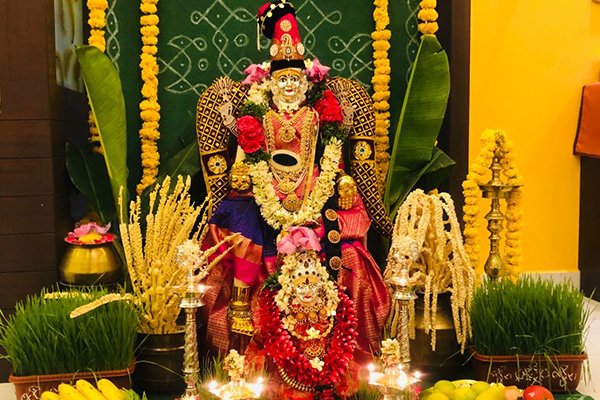
Varalakshmi or Varamahalakshmi Vrata is dedicated to the Goddess of Fortune Lakshmi. It is the only festival wherein the goddess grants boon or wish fulfilment. ‘Vara’ means ‘Boon’, ‘fulfillment of wishes’. On this day, a special Lakshmi puja is performed in order to please the goddess of fortune auspiciousness. The Sanskrit word ‘Lakshya’, which means ‘aim’, also comes from ‘Lakshmi’. It signifies our purpose (aim) in life to attain both, material prosperity and spirituality. Lakshmiji, when pleased with the pure heart of her worshipper bestows upon them both.
Read More: Varalakshmi Vratam
Kajari or Hariyali Teej (Saturday, 15 August 2026)
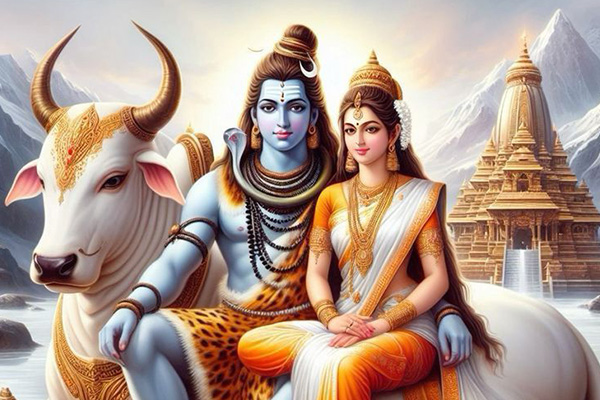
Teej is chiefly associated with marriage in India. The marriage ceremony is considered one of the highly honored rituals in the Vedas. During the Teej festival, married women fast for the longevity of their husbands. Unmarried girls can also fast and offer prayers for suitable life partners. Kajari Teej is celebrated on the third day of Krishna Paksha (dark fortnight) of Bhadrapada (Aug-Sept). Kajri Teej is also known as ‘Kajli Teej’ and ‘Badi Teej’. There are other Teej festivals, also known as Hariyali Teej, Kajari Teej and Hartalika Teej. Along with these, we also have Akha Teej, popularly known as Akshaya Tritiya.
Read More:
Hariyali Teej 2024
Krishna Janmashtami (Friday, September 4, 2026)
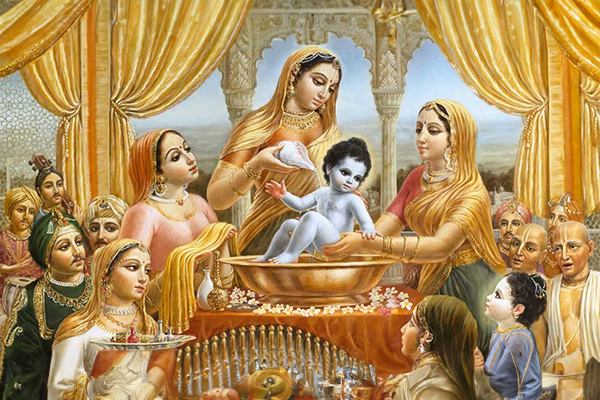
Krishna Janmashtami is a festive ceremony performed across India to celebrate the birth anniversary of Lord Vishnu's eight incarnations, Lord Krishna. It marks the 5247th birth anniversary of the Lord. August-September (Shravana month) is the time when Janmashtami is celebrated. Those who plan to fast on the day of Janmashtami should eat only a single meal on the previous day. During Janmashtami devotees should take a Sankalpa to observe a one-day-long fast and break it the next day after Rohini Nakshatra and Ashtami tithi are over.
Read More: Krishna Janmashtami
Rakshabandhan (Friday, 28 August 2026)
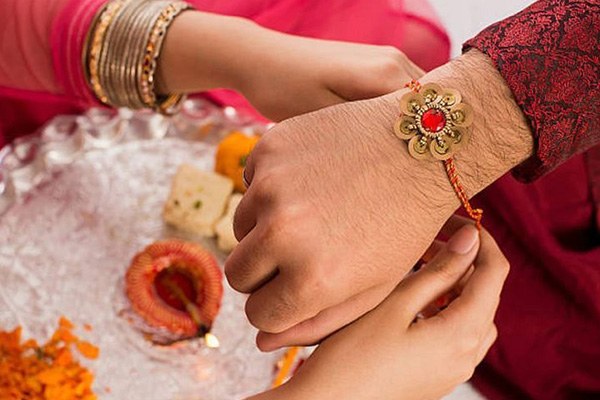
Rakshabandhan is a traditional Hindu festival that celebrates the bond between brothers and sisters, observed on the full moon day of the lunar month of Shravan (July/August). Rooted in Vedic customs, the festival involves sisters tying a sacred thread, or rakhi, around their brothers' wrists as a symbol of love and prayers for their well-being, while brothers vow to protect their sisters throughout their lives. This ritual, often accompanied by the exchange of gifts and sweets, highlights the importance of familial relationships and mutual respect, bringing family members together to reinforce their bonds and foster unity and harmony. In essence, Rakshabandhan is a heartfelt celebration of love, protection, and the enduring ties that bind siblings.
Read More: Rakshabandhan
Gayatri Jayanti (Friday, August 28, 2026)
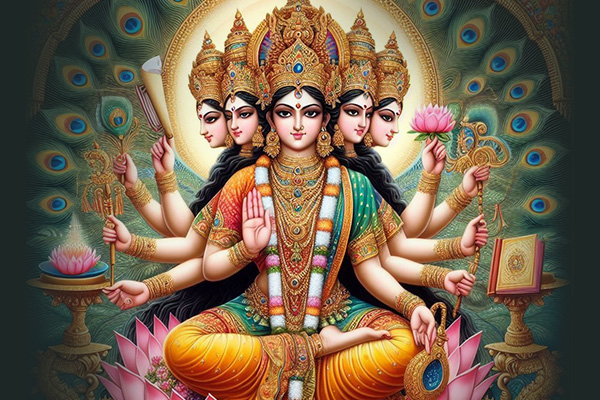
Gayatri Jayanti is the appearance day of Goddess Gayatri, who is regarded as the mother of Vedic literature. She is said to be a divine manifestation of all phenomenal characteristics of the supreme Brahman. One often identifies Gayatri with Saraswati. However, she is the embodiment of Saraswati, Parvati and Lakshmi, representing knowledge, beauty and opulence, respectively. The celebration of Gayatri Jayanti takes place during Shravan Purnima in South India, with some celebrating it on Shukla Paksha Ekadashi during the Jayeshtha Lunar month. It is said that Goddess Adishakti took the form of Gayatri and killed the demonic Vetrasura on this day.
Read More: Gayatri Jayanti
Rishi Panchami: (Tuesday, September 15, 2026)
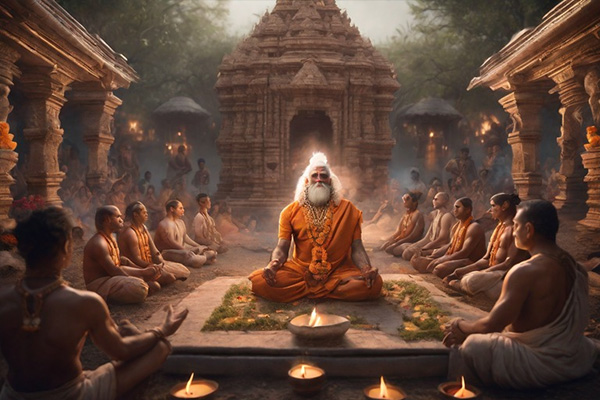
Rishi Panchami is a Hindu festival celebrated on the fifth day of the Hindu lunar month of Bhadrapada. It honors the Sapta Rishis (Seven Sages) and seeks forgiveness for any transgressions against them. Devotees observe fasting and perform rituals including taking baths in sacred rivers. It is particularly significant for women who seek purification after menstruation and childbirth. The day is marked by prayers, offerings, and acts of charity to honor the revered Rishis and seek their blessings.
Pujas Performed In Shravan Maas
Shiva Puja At Trimbak Temple
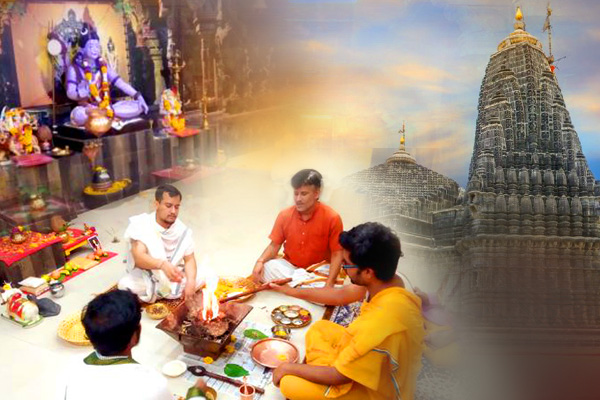
CLICK HERE TO BOOK PUJAS AT TRIMBAKESHWAR
Performing a Shiva Puja at Tryambakeshwar Temple during Shravan is one of the most auspicious spiritual and uplifting activities. Trimbakeshwar temple is one of the ancient Shiva temples and is one of the twelve Jyotirlingas. The place is highly recommended for Shiva pujas and religious rituals.
Rudram Chamakam Yagna Puja
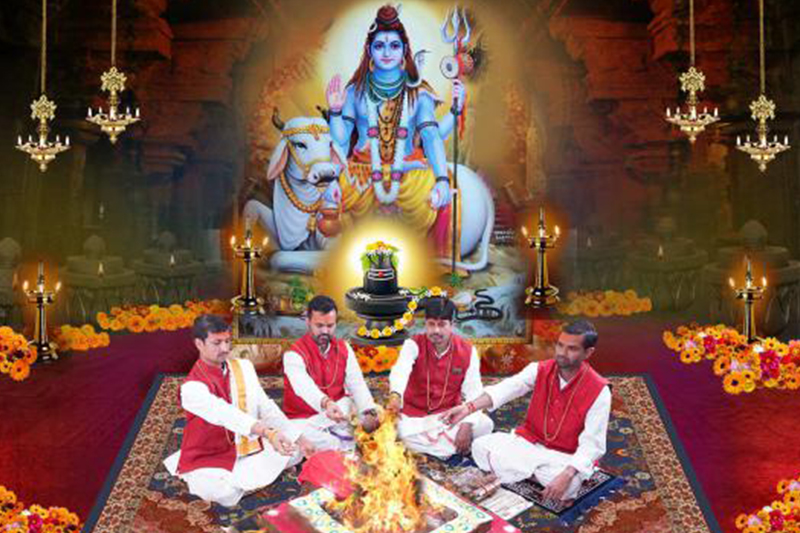
CLICK HERE TO BOOK RUDRAM CHAMAKAM YAGNA PUJA
Shri Rudram is one of the oldest names of Lord Shiva. Through the chanting of Sri Rudram, Lord Shiva's various attributes and aspects are invoked and worshipped. By the power of Shri Rudram sick become well, the unmarried find the ideal mates, debts are removed, wealth and power are showered, and all the ills are kept at bay.
Mangala Gouri Puja
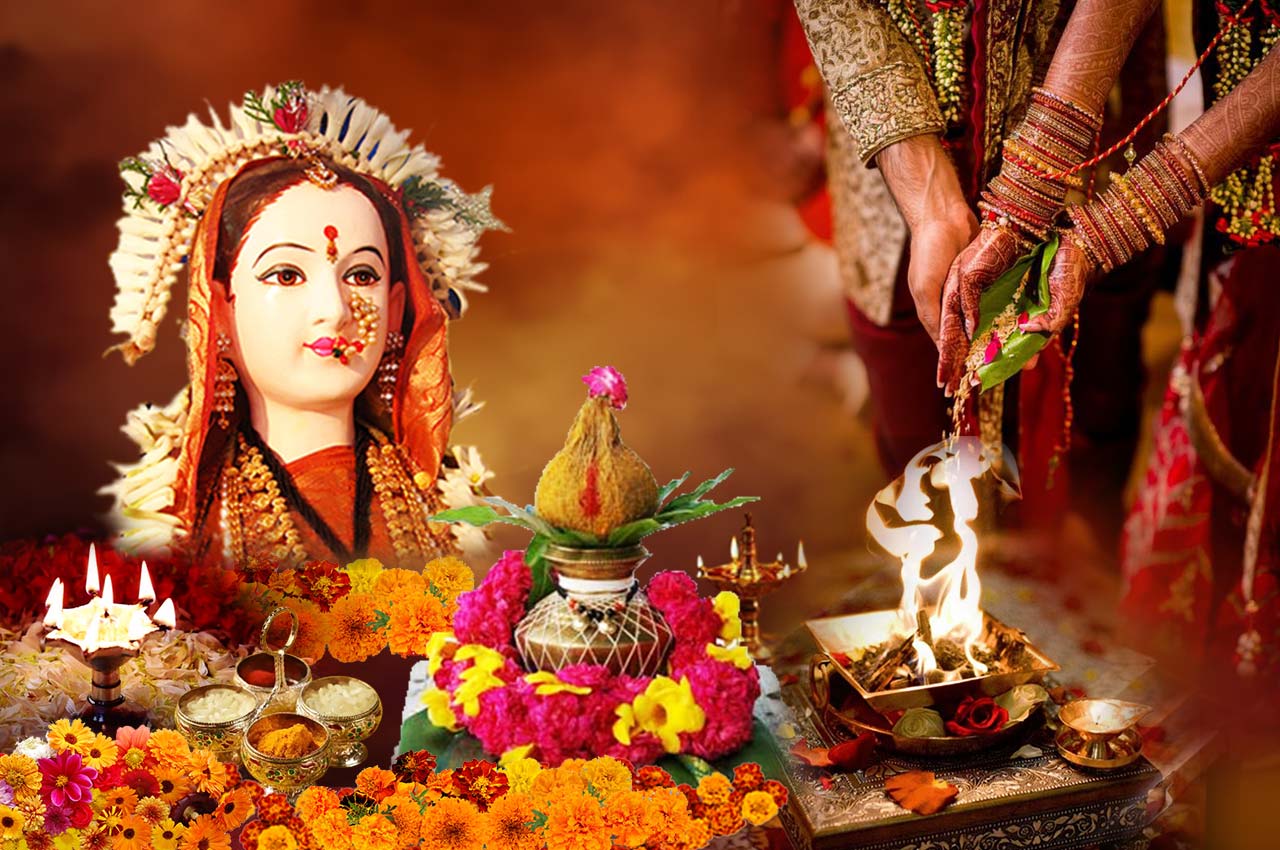
CLICK HERE TO BOOK MANGALA GOURI PUJA
Alongside the above popular Shiva Puja, one can perform Mangala Gouri Puja on Tuesday. Goddess Maha Gauri is worshipped for Her blessings for desire fulfilment. Observing fast and worshipping Goddess Mahagauri during Shravan Maas is immensely fruitful, especially for unmarried girls and married women.
Mahamritunjaya Puja
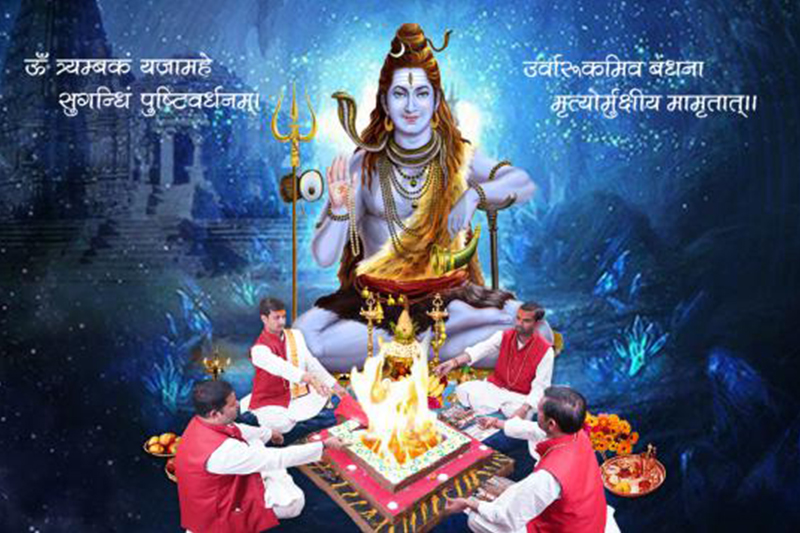
CLICK HERE TO BOOK MAHAMRITUNJAYA PUJA
Maha Mrityunjaya Puja is done for long and healthy life and to get rid of prolonged sickness. Mahamrityunjaya Mahadev is the conqueror of death. The Mahamrityunjaya Mantra helps overcome all sorts of negativities fears and induces deep spiritual self-realization. Shiva is the soul, and prayer to Him makes one realize the eternity of self and thus removes the fear of death
Shiv Parivar Puja
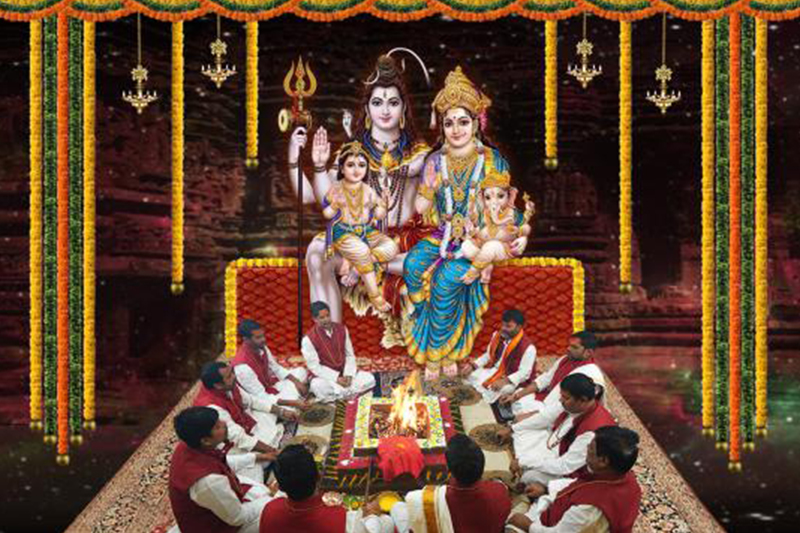
CLICK HERE TO BOOK SHIV PARIVAR PUJA
The Shiv Parivar Pooja is performed to get family bliss and seek blessings of the divine family of Lord Shiva that has four members, namely, Lord Shiva, His consort Parvati, and the two sons, Kartikeya (Subramanya) and Ganesha (Vinayaka). The Shiva Parivar is a symbol of harmony, prosperity, and completeness. The Shiva Parivar in itself encompasses the entire universe and the essence of the entire universe.
Parthiv Shivling Puja
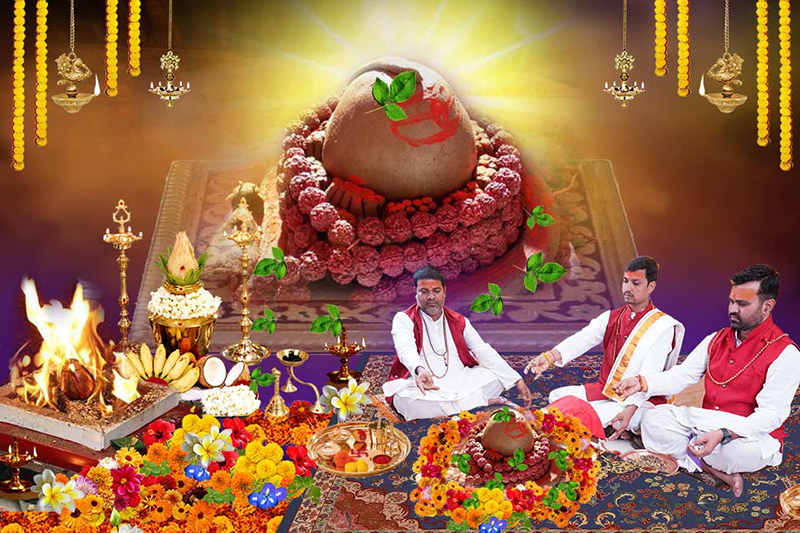
CLICK HERE TO BOOK PARTHIV SHIVLING PUJA
Parthiv Shivling puja is very auspicious and generally done throughout the Shravan Maas, especially on Mondays of that month. Twelve Parthiv Shivlings are made and worshipped following the puja vidhi (rituals). The worship includes offerings of Bael or Bilwa leaves, White Kaner flower (Oleander), Milk, Sugar and Rice grains on top of the Shivling. The rest of the day should be spent in chanting mantras and singing the praise of Lord Shiva.


-in-Astrology.jpg)
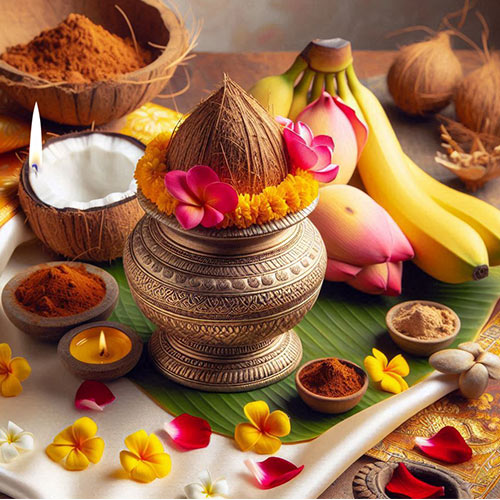
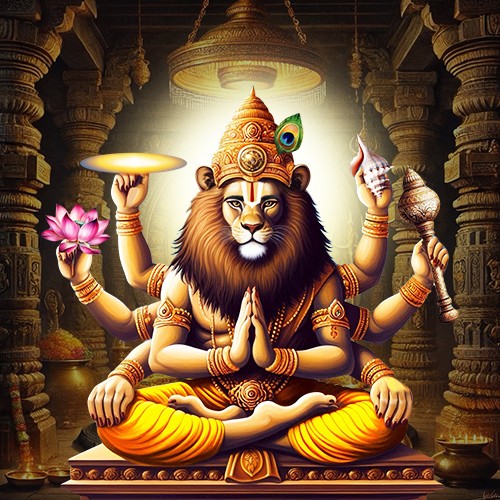
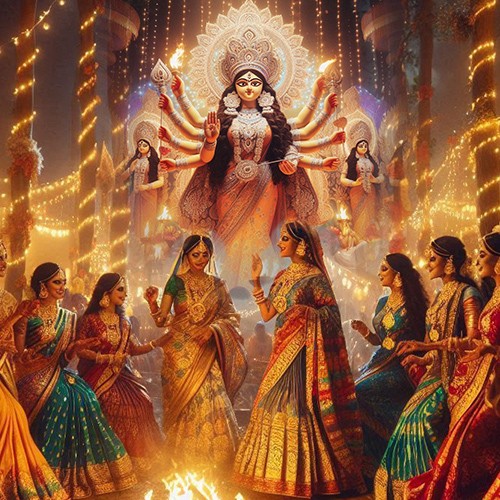
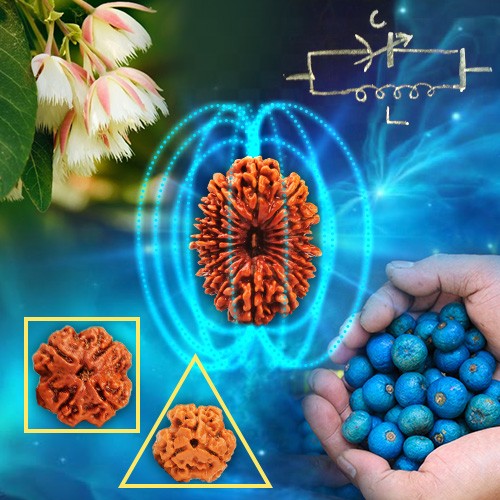

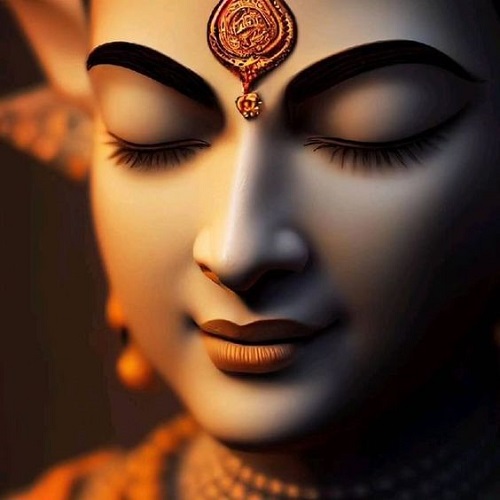
.jpg)

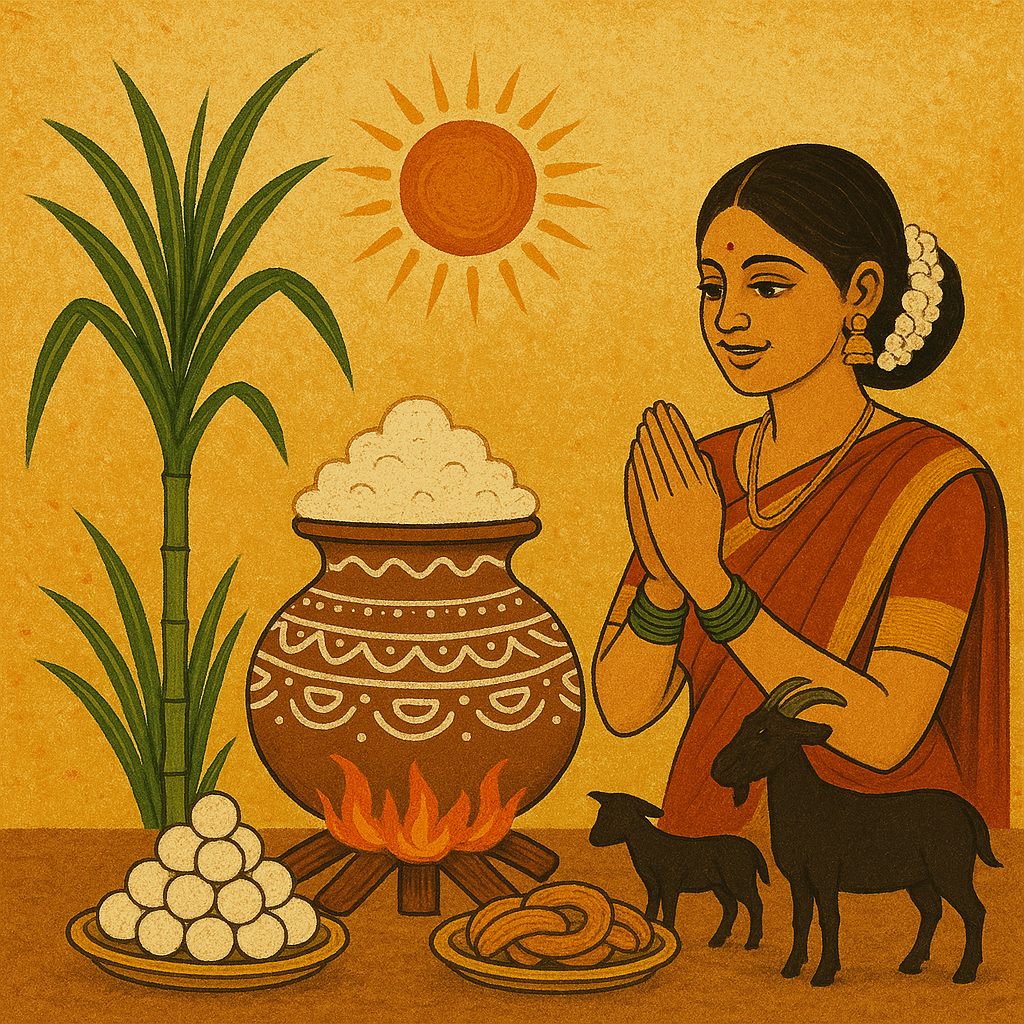
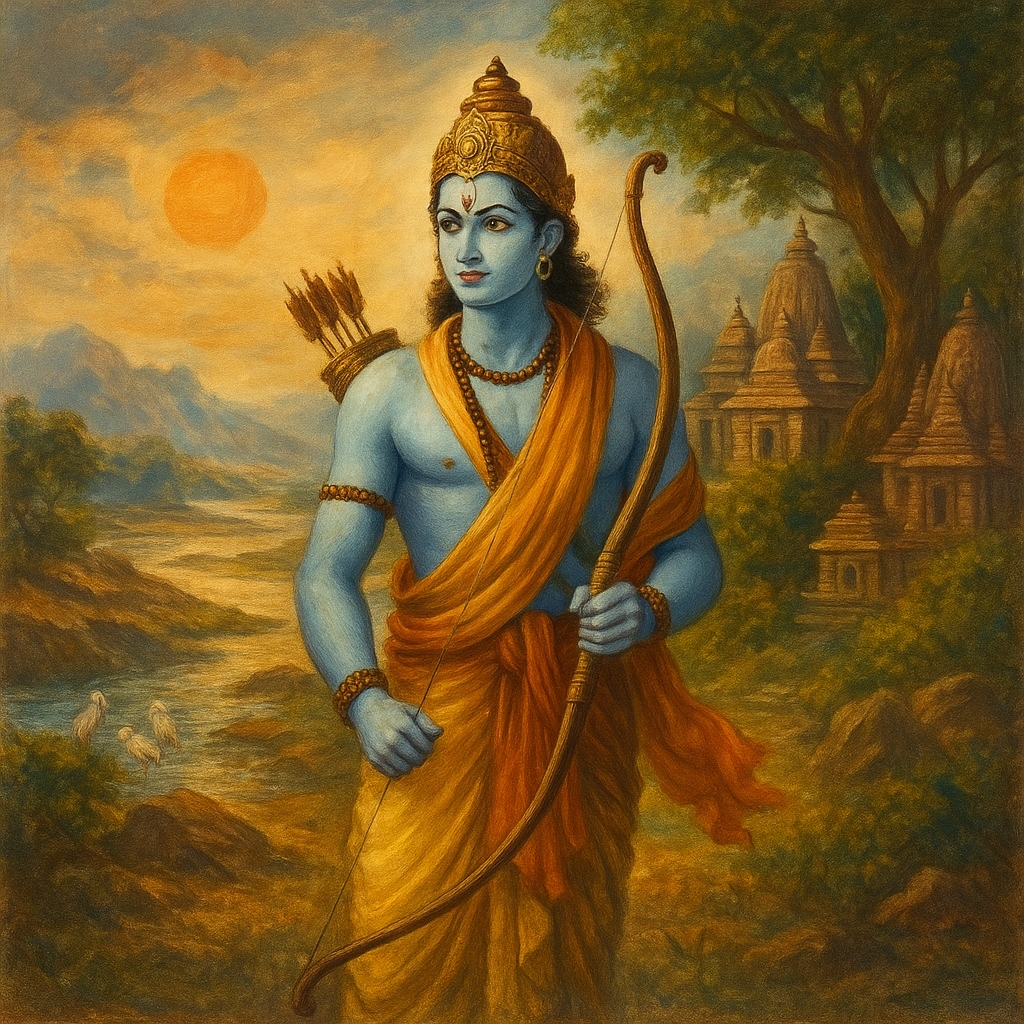
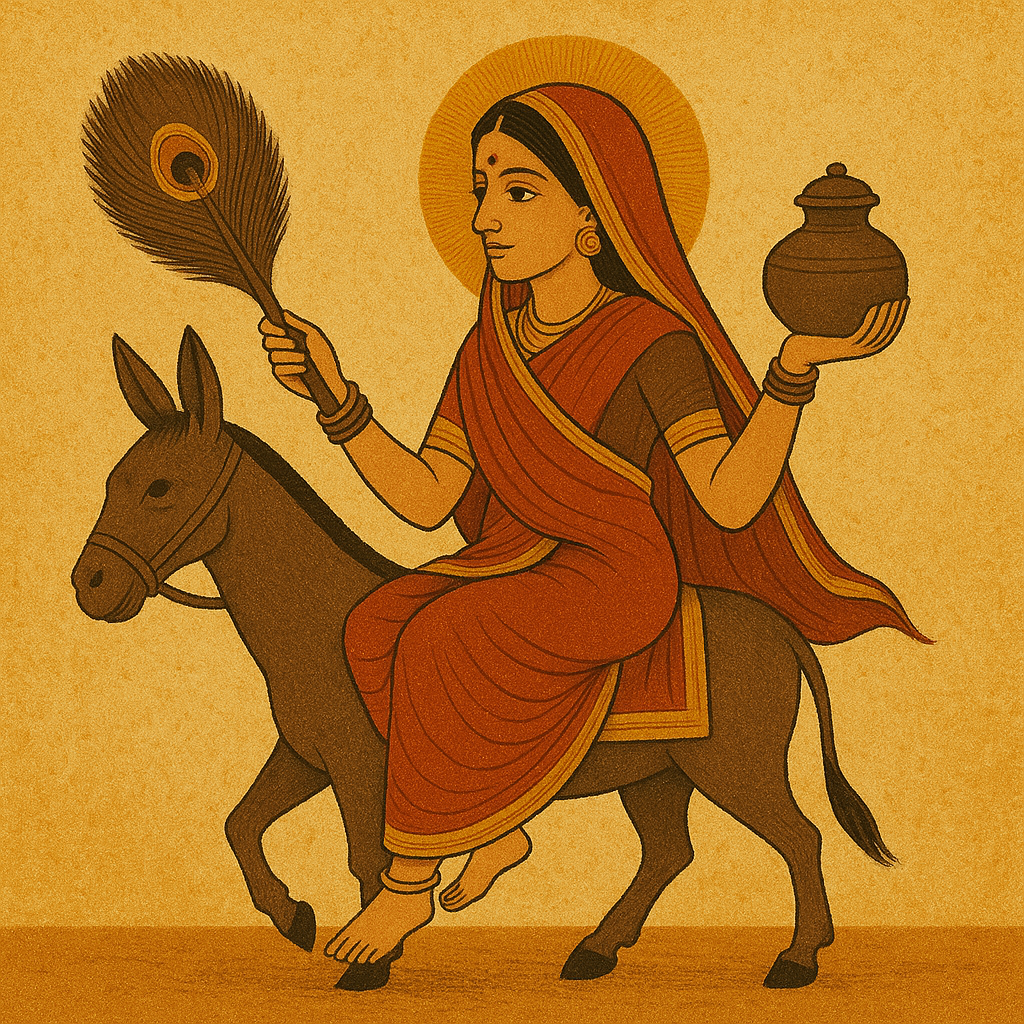
Melanie xavier
|January 9, 2025
Housewife
Dr Jagjeevanram TK
|July 2, 2024
HAR HAR MAHADEV JAI SRI RAM. VERY VALUABLE INFORMATION ABOUT SHRAVAN AND OTHER FESTIVALS DURING THE MONTH.vVZJ
Sunita Rawat
|June 10, 2024
Sawan mass mai vrat kis din rakhte h
SONAm
|June 6, 2024
Peace